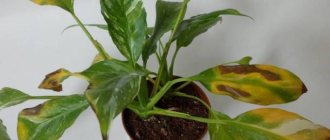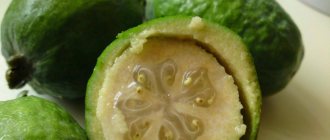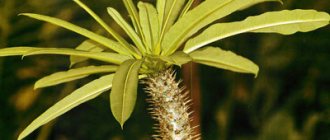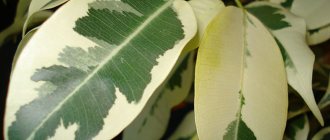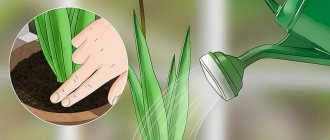Pachypodium is a genus of tree-like plants in the Kutrovaceae family. Such plants can be found in nature in the arid regions of Madagascar, Australia and Africa. This genus includes 23 species. From Greek “pachypodium” is translated as “thick leg”; the fact is that the bush has a fleshy, voluminous trunk covered with thorns. Under natural conditions, such a plant has a height of about 8 m, and its trunk reaches 1.5 m in diameter. However, when grown indoors, the height of the bush does not exceed 100 cm.
Characteristics and description
Pachypodium or in Latin Pachypodium comes from the Kutrovaceae family and is a perennial succulent in the form of a tree or shrub. It came to indoor culture from the hot places of Australia, southern Africa and Madagascar. Popularly, this succulent even received the nickname “Madagascar palm ,” although it has nothing to do with palm trees. Only its appearance in adulthood, when a tall, prickly stem is crowned with a tuft of long leaves, creates the impression of similarity with this tropical tree. The Latin name of the plant comes from the phrase “thick leg,” which indicates the impressive size of the stem.
In nature, the slow-growing pachypodium sometimes grows up to 10 m, while indoors - up to 30 cm (maximum for some species) or up to 1.5 m. You can admire the “green friend” for 15 years or longer, depending on the conditions of detention.
Some flora lovers notice in pachypodium a resemblance to milkweed, and this is not accidental. The plant is also poisonous and dangerous, but its juice does not leave burns on the skin. Still, it is better to avoid contact with milky sap, replant the tree very carefully and place it away from children and animals so that they do not get hurt by sharp thorns.
The leaves of the Madagascar palm are simple and entire and grow from the very top of the trunk. The stem of the tree is very thick, fleshy and covered with sharp spines. The flowers collected in brushes are snow-white, quite large and elegantly tubular in shape. They open up and delight the gardener with their beauty mainly during the day.
Features of the pachypodium
Pachypodium is a succulent tree or shrub. With a large number of differences between varieties and species, such plants have such a characteristic feature as a thick trunk, in which a supply of liquid accumulates in case of drought. Externally, the species that make up this genus differ greatly from each other: from cactus-shaped trees to bottle-shaped dwarfs. Almost all types of such plants have thorns, which are grouped in 2-3 pieces; they are placed around the trunk in rings or spirally. Only some species of this genus do not form branches, while the remaining species are distinguished by fairly strong branching. This genus differs from other representatives of the Kutrovye family in that the juice of such plants is clear and not milky, but it is still poisonous. When grown at home, the height of pachypodium varies from 0.3 to 1.5 m, while its lifespan is 3–15 years.
Pachypodium
Kinds
There are at least 20 varieties of this amazing succulent. In indoor floriculture you can find:
- Pachypodium Lamera, or in Latin Pachypodium lamerei Drake , is a tree that is very popular in home culture. A powerful, sometimes branching, stem with spines and dark green leaves forming a rosette at its top make the plant a classic representative of the genus. The flowers are creamy or soft pink in color with a yellow throat and up to 11 cm in diameter. The spines are located on tubercles arranged in a spiral - 3 pieces on each. In a room, this representative of the flora grows up to 50 cm.
- Pachypodium Jayi, otherwise called Pachypodium geayi , is a tree up to 60 cm in height with a powerful trunk strewn with “needles.” Very similar to P. Lamera. It differs from it only in narrower and pubescent leaves. The flowers are white with a yellow throat.
- Pachypodium brevicaule, also known as Pachypodium brevicaule, is an unusual variety that looks very stone-like after shedding its leaves. Its flat and smooth stem, gray in color and up to 60 cm in diameter, is completely invisible in nature - its color blends so well with the sand. The yellow inflorescences look very impressive compared to the stem itself.
- Pachypodium lamerei branched or otherwise Pachypodium lamerei var. ramosum is distinguished by a bottle-shaped woody stem and a small number of thorns. Forms thorny shoots. White flowers growing in umbrella inflorescences reach 10 cm in diameter.
- Pachypodium Saunders, whose name in Latin sounds like Pachypodium saundersii, is interesting because of its spherical stem of gray-green color, no more than 1.5 m high, covered with a small number of thorns. The leaves are wide with a tapering base, and the flowers are white, decorated with pink edges.
- Pachypodium succulent or otherwise Pachypodium succulentum is a variation with a huge woody stem, similar to a cobblestone and slightly buried in the ground, small pubescent leaves and pairs of “needles”. The bell-shaped buds are distinguished by their pink color and red “sparks” from the center.
- Pachypodium densely flowered, in Latin called Pachypodium densiflorum - a variation with rich yellow inflorescences, very slow growing. Flowering occurs when the stem thickness is about 30 cm in diameter, maximum height is 45 cm. Small leaves point upward.
- Pachypodium Horombenze or in Latin Pachypodium horombense Poiss is a low-growing variety with a powerful smooth stem, thin leaves in rosettes at the ends of the shoots and large yellow flowers growing in clusters.
- Southern Pachypodium, otherwise called Pachypodium meridionale , is interesting with its very large and fragrant pink-red flowers. Over time it reaches up to 1 m. Its trunk is smooth and silvery-brown.
- Pachypodium rosette, in Latin called Pachypodium rosulatum , is a form with a short but powerful trunk (caudex), spiky branches growing upward and soft yellow or green-yellow inflorescences.
- - a species up to 60 cm high, with a spiny or smooth caudex and elongated spiny branches. Narrow leaves are located in rosettes at the top of the shoots. The inflorescences are painted in a bright yellow hue.
- Pachypodium Rutenberg, whose name otherwise sounds like Pachypodium rutenbergianum , is a variety with a caudex up to 60 cm in diameter, spiny branches, and rosettes of glossy dark green leaves. The flowers are large and white.
Types and varieties of pachypodium with photos and names
Pachypodium lamerei, or Madagascar palm
This species is a tree whose height can reach up to 600 cm. Its trunk is thick and prickly. In adult specimens, the foliage at the top of the trunk is located almost the same as in a palm tree; it is with this feature that the second name of this species is associated. The thickened, erect stem becomes lignified in the lower part; on its surface there are protruding tubercles, which are arranged in a spiral. Each such tubercle has 3 powerful spines. A rosette is formed on the upper part of the stem, which consists of dark green petiolate leaf plates with an elongated lanceolate shape, their length varies from 0.2 to 0.4 m. 3 bare spines grow under each leaf plate. The white-cream or pale pink flowers have a yellow center and reach about 11 centimeters in diameter. Green fruits are oval in shape. When grown indoors, the height of the bush does not exceed 50 cm. This species has several varieties:
- typica - the underside of the leaf blades is pubescent;
- ramosum - a branched trunk is decorated with leaf plates with a pronounced central vein; umbrella-shaped inflorescences consist of white flowers, which reach about 10 centimeters in diameter.
Pachypodium geayi
The height of such a tree varies from 300 to 600 cm. Its trunk is thick and covered with thorns. While the plant is young, it is very similar to Pachypodium Lamera, but its foliage is narrower (width from 10 to 30 mm), and there is pubescence on its surface. The color of young spines is grayish, but the tips are painted black. White flowers have a yellow center. At home, the height of the bush does not exceed 0.5–0.6 m.
Pachypodium brevicaule
There is no foliage on the bush; it looks like the gray stones that surround it in natural conditions. The tuberous flat stem, covered with spines, reaches a height of about 0.6 m. During flowering, elongated yellow flowers open on the bush.
Pachypodium saundersii
The stem of such a succulent plant is greenish-gray, almost spherical in shape; it reaches a height of about 150 cm. On the surface of the bush there is a small number of thorns, which reach 25 mm in length. The shape of the leaf blades is broadly lanceolate, with a pointed apex. During flowering, a large number of white flowers grow on the bush, with a pink stripe on each petal.
Pachypodium succulentum
The bush has a turnip-shaped root, which gradually turns into a thickened tuber, reaching 15 centimeters in diameter. Higher up, the root becomes a stem, which becomes lignified over time, it is branched and branched, and its height varies from 0.6 to 0.9 m. On young branches there are paired spines, the length of which is from 10 to 20 mm, and also slightly pubescent leaf plates lanceolate in shape, their length is about 50 mm, and their width is up to 10 mm. Flowering is observed in summer, at which time the bush is decorated with bell-shaped flowers of light pink color with a red throat, their diameter is about 40 mm.
Pachypodium densiflorum
This succulent shrub is characterized by slow growth, its height does not exceed 0.45 m. The fleshy trunk of a greenish-gray color is covered with thorns, it reaches 0.3 m in diameter. At the apical part of the trunk there is a leaf rosette consisting of leaves, the front surface of which is green , and the back is gray felt. Tubular, rich yellow flowers reach 30 mm in diameter, they have a widened end, and the yellow anthers present form a cone.
Pachypodium horombense
This not very tall plant has a smooth, wide, greenish-silver trunk that is thick at the base. Narrow small leaf blades of a greenish-gray color form rosettes on the tops of the branches. Yellow flowers are on long stalks.
Southern Pachypodium (Pachypodium meridionale)
In nature, such a plant reaches a height of 300 cm, but when grown at home, the bush does not grow higher than 120 cm. The narrow and long leaf plates are green in color. The smooth brownish-silver trunk reaches about 0.6 m in diameter. The large flowers have a pleasant aroma; they consist of a pale red corolla and pink petals.
Pachypodium rosulatum
This fleshy succulent plant has vertically arranged cylindrical branches and a caudex. The greenish-gray short trunk is thickened at the base. There are a large number of spines on the surface of the branches. Leathery, shiny green leaf blades of a narrowed-oblong shape have a light-colored central vein. The foliage grows at the tops of the branches, and it is collected in rosettes or whorls. Few-flowered racemose inflorescences with long pedicels consist of tubular flowers of yellow or yellow-green color.
This species has a variety - graceful (Pachypodium rosulatum var. Gracilius): the height of the bush is from 0.4 to 0.6 m with a caudex of brownish or gray color, it is round and slightly compressed from the sides, it can be smooth or there is a large number of spines. The branches are twisting and short, they can be prickly or smooth. There are leaf rosettes at the tops of the branches. The rich yellow flowers are collected in groups on long stalks, they are tubular and have a wide end.
Pachypodium rutenbergianum
In nature, such a caudex plant reaches a height of 8 meters, but when grown at home it does not grow higher than 0.6 meters. On the surface of the short branches there are spines reaching about 10 mm in length. The dark green, shiny leaf blades have an oblong shape and a light central vein. They are collected into rosettes on the tops of branches. The length of the foliage is about 15 centimeters, and its width is up to 4 centimeters. The terminal inflorescences consist of 3 or 4 large white flowers, which have a tube widened towards the end.
Madagascar palm / Pachypodium lamera
Home care
Pachypodium has recently gained popularity and a place on window sills. Just 10 years ago, few people knew about it and the plant was considered a rarity. Then flower growers took a closer look at the plant and discovered that this representative of the flora is not prone to whims: due to its undemanding nature and the lack of need for cold wintering, it is very convenient for indoor growing. Now the succulent is very common in culture, and this has been facilitated by the fact that it does not require any complex care.
After all activities for caring for the “palm”, which must be carried out with rubber gloves , it is important to wash your hands thoroughly.
Lighting and temperature
Great news - pachypodium does not need shading; it loves direct rays of the sun , but also takes root in partial shade. A south, south-west or south-east window is ideal for growing, but your pet will not die if placed in a different position. In summer, it is advisable to take it out into the garden or onto the balcony. The only caveat is that the succulent must gradually become accustomed to the bright rays
"Madagascar palm" is afraid of drafts, but likes frequent ventilation and prefers temperatures of 16 °C and above in winter and from 18 to 30 ° C or above in summer. Unlike many other representatives of the flora, it will take root perfectly on the windowsill next to the radiator!
Planting and replanting after purchase
Young pachypodiums are replanted annually in the spring, and adults - every 2-3 years . Delicate roots and slow growth are the reasons for rare and very careful transplantation. It is advisable to replant a newly acquired plant - the transport soil mixture is sometimes entirely peat, which means that there is a risk of waterlogging. In addition, changing the soil will protect the “Madagascar palm” - if there were pests in the ground, they will be neutralized. In addition, you should carefully examine it or even wash the leaves with laundry soap and rinse under a warm shower.
Priming
The best substrate for replanting will be obtained by mixing leaf and turf soil with perlite or coarse sand in equal Another option:
- 1 part turf soil
- 1 part ready-made cactus mixture
- 0.5 parts peat
- 1 part perlite or coarse sand
The most important condition is that drainage should occupy from a third to half the volume of the pot. It is useful to add pieces of clay, charcoal or brick to the substrate. The holes in the bottom of the container must be large! You can also grow palm trees using hydroponics.
Fertilizer/feeding
In spring and summer, pachypodium will benefit from fertilizing every two weeks with fertilizer for succulents. In the first month or two after transplantation, it is not fertilized - the additives included in the soil are enough for it.
Watering and air humidity
The fleshy trunk of the pachypodium perfectly stores moisture - this makes it not afraid of drought and dry air. However, there is a trick - the perfect balance between moderate watering and drought gives the green pet the best shape. If you overdry a succulent, it will lose its foliage, and if you overwater, the trunk will become excessively elongated.
The optimal watering regime is abundant from March to October, but without waterlogging, and moderate in the remaining months. This means that in the warm season they water every 1-3 days , and in winter - 1-2 times a week or month (as the top layer of the substrate dries).
It is possible to spray the “Madagascar palm”, but not necessary. She will appreciate regularly wiping the leaves with a damp cloth. Water is required to be warm and settled.
Pests and diseases of pachypodium
Diseases
When grown indoors, pachypodium is highly sensitive to too much moisture, and this is expressed in the appearance of various rots. In order to protect the bush from fungal disease, it must be properly watered. It should also be taken into account that such a succulent plant tolerates drought much more easily, but stagnation of water in the substrate can cause rotting and thinning of the stem, as well as blackening and flying of the leaves. As soon as you notice that the bush has begun to rot, you should immediately stop watering and put it in a warm place. The plant and soil mixture in the pot must be sprayed with a solution of a fungicidal preparation, and in order to prevent relapses, the watering regime must be reviewed.
Harmful insects
If the air humidity in the room is too low, then spider mites can settle on the plant and suck out the cell sap from the bush. It is almost impossible to see such a mite with the naked eye, but a sure sign that the bush is occupied by such a pest is the presence of a thin web on its surface. To get rid of this pest, the pachypodium must be thoroughly rinsed under a warm shower, and it is also recommended to increase the air humidity in the room. To do this, every evening the plant must be moistened from a sprayer with well-settled lukewarm water. In the case when there are a lot of ticks on the bush, acaricides such as Actellik, Fitoverm, Aktara or Akarin are used to destroy them.
If the room is relatively hot and the air humidity is low, then thrips can settle on the pachypodium. This pest also sucks cell sap from the flower. In this case, light-colored dots and silvery stains form on the front surface of the leaf plates. At the same time, the harmful insects themselves are located on the underside of the foliage. You can get rid of such a pest using the same drugs that are used in the fight against spider mites.
Reproduction
Pachypodium reproduces in several ways:
- Seeds. First, they are soaked in warm water for a day, then evenly distributed over the surface of wet sand and sprinkled with the thinnest layer of the same substrate (about 0.5 cm). Germination takes 3-4 days, several months or even six months.
- Stem pieces. This is a problematic method, with almost zero rooting observed. A mixture of peat and sand is used.
- By cuttings. The method is suitable for Pachypodium Lamera. In summer, the cuttings are separated, dried for 5 or 8 days on a sheet of paper, and then placed in a mixture of sand and peat. Warmth, light and constant light moisture in the substrate are important conditions for success.
Bloom
The flowering period occurs in spring or summer, depending on the variety. Only specimens that have reached 6-7 years of age are covered with flowers. Different species have inflorescences of white, yellow, red, pink shades, some are fragrant. They last on average about a week.
From the second half of October to February, pachypodium goes into hibernation. During the rest period, it may remain completely without leaves. When new ones grow, the “crest” of them moves a little higher.
Reproduction of pachypodium
Growing from seeds
Pachypodium can be propagated by seed (generative) method, but it should be noted that it is quite difficult to obtain seeds of such a plant indoors on your own. When sowing, seeds are buried 5 mm into the substrate, and the container must be covered with film or glass on top. Then the crops are harvested in a well-lit, cool (about 20 degrees) place. When the first seedlings appear, the shelter should be removed, but this is done gradually, accustoming the plant to new conditions. After the seedlings have become stronger, they should be planted in individual pots, and then they are provided with the same care as adult bushes. Before choosing this method of propagation, you need to take into account that pachypodium grows from seeds very, very slowly.
Cuttings
This plant can be propagated by cuttings, but such cuttings very rarely root normally. However, there are cases where the top of a bush that had rotted at the base was cut off, and it successfully took root. To do this, cut off the upper part at a height of 15 centimeters using a very sharp, pre-sterilized tool, sprinkle the cut area with crushed charcoal, and then plant the cuttings in a soil mixture intended for planting an adult pachypodium (see above). Place the cutting in a well-lit place.
Common problems
- If you water the palm tree excessively, it may lose all its foliage.
- Fresh leaves darken and fall off - too little light or watering with cold water.
- With poor watering, the succulent loses its lower leaves.
- Cold and excessive watering can cause the trunk to rot.
- The foliage withered and the stem shriveled - too little watering.
Pests
Pachypodium can be attacked:
- Red spider mite
- Shchitovka
- Thrips
- aphids
fight enemies using traditional methods or insecticides. Often, simple laundry soap, which is used to wash the victim, helps to cope with them.
Pachypodium is an unusual and original plant that can emphasize the originality of the gardener. Impressive spines, expressive “hair” and delightful flowering - all this speaks in its favor. You just need to give the succulent the right conditions and minimal care - and your green favorite will delight you with a lush rosette of leaves, a beautiful and strong stem and the most delicate fragrant flowers.
Photo
See more photos of the pachypodium:

